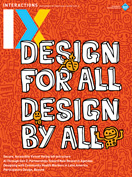Authors:
Miriam Sturdee
Lou Rosenfeld, founder of UX book publisher and conference producer Rosenfeld Media, is doing his best to be thoughtful about AI (but he’s still worried nonetheless).
"It's a terrible time in the design world, with so many layoffs, and many design skills being automated...but I feel we're in for an interesting reset."
— Lou Rosenfeld
Text version
After a few false starts, and incompatible time zones and meeting slots, I finally pin Lou Rosenfeld down in the early morning (his time) while the kids are getting ready for school and bright morning light is spilling into the corner from which he has chosen to speak to me. My collaborator, Mafalda Gamboa, joins us, interested in the process.
It’s always interesting meeting someone virtually for the first time synchronously, but nerves give way to easy chat—Lou is a people person, which is probably how he has built such a vibrant company. Inevitably (for this feature at least!) the conversation soon turns to AI.
It’s a terrible time in the design world, with so many layoffs, and many design skills being automated…but I feel we’re in for an interesting reset.
This is a period of retooling—literally—and our employers are automating many aspects of design and research.
But people are going to be needed to manage the platforms that support design and research.
This is relieving to hear; it has been playing on a lot of people’s minds lately. He goes on to say so many of these people who have been laid off are going to find themselves back in demand at some point, although nobody is sure when.
Technology is running ahead. It never eliminates people 100 percent, but it certainly changes our roles. We just haven’t figured out where the humans fit within these new infrastructures yet.
Everyone thought TV would kill radio, and as a publisher, I saw this with e-books too: The ecosystem changes dramatically—and then it stabilizes.
As someone who has both a 2011 e-reader and who has hoarded hard copy science fiction titles from the 1980s until this year, I can believe this. People do have e-readers, but they also still read physical books. It is the same with vinyl records—there is something delightfully “real” about the solidness of something you can’t lose during a power cut.
I’m finding it especially interesting to consider how books are being connected to broader digital learning environments through AI. We just started an AI project where you’ll be able to ask questions of our books and other content, but with real citations, so the sources are very clear.
This is interesting. A lot of people are now looking into training these smaller systems, but people rarely have access to a reliable training dataset. And if they have a limited dataset, what bias could be introduced? With so many voices at the disposal of Rosenfeld Media, Lou could be onto something really good.
As a publisher, conference producer, and community host, I’ve worked with hundreds of voices to curate and edit their content, so it’s of really high quality. There’s something you can trust about that.
While I’m comfortable about our quality, new technologies always bring unintended consequences. I worry about that a lot, even though I think people trust our brand.
Trust in AI is currently the focus of many research programs here in the U.K. (from my perspective), and I imagine it is also of interest to other researchers around the world. I’ve already found that AI search is giving me inaccurate information as the first result—hardly dangerous in terms of identifying British birds (it WAS a Nuthatch!)—but how many people won’t be able to confirm their suspicions?
It’s very easy to jump right into AI without looking. But I know that people in our field are naturally humanitarian and care about the user.
So our AI, like our books and other products, should be designed to care about people too.
It seems like a good place to wrap up, although we chat a bit more about sketchnoting, and how it has become a valuable addition to the conferences he produces—well, it is Conversations in Sketch, after all! I also ask for some photographs for source material, which his family finds somewhat hilarious. Much later, I sit with a drink and attempt a likeness, which is on the first page of the printed feature.
Miriam Sturdee is a lecturer at the University of St Andrews working on intersections of art, design, and computer science. She is a practicing artist and designer and has an MFA in visual communication. Her publications explore areas of futuring, sketching and drawing, alternative research outputs, and psychology. [email protected]
Copyright held by author
The Digital Library is published by the Association for Computing Machinery. Copyright © 2024 ACM, Inc.










Post Comment
No Comments Found